Baby feeding weaning
What You Need to Know – Cleveland Clinic – Cleveland Clinic
During their first few years of life, babies reach many important milestones: first smile, first laugh, first crawl, first steps. In between all these, babies also learn an abundance of important life skills, such as how to feed themselves. In the process, what they eat evolves.
“Babies will gradually transition off of a full breast milk or formula diet to a varied diet of solid foods,” says pediatrician Kimberly Churbock, MD.
What this transition looks like varies because there are multiple ways babies can learn how to feed themselves. One option is baby-led weaning, or baby-led feeding.
What is baby-led weaning?
When babies are learning how to feed themselves, they’ll commonly start eating exclusively pureed foods and then progress through different (and increasingly more complex) stages of pre-made baby foods before graduating to solids. Until babies are strong enough to eat on their own, parents focus on spoon feeding.
Baby-led weaning flips the script and puts babies in charge of mealtime.
“The basic idea behind baby-led weaning is that parents and caregivers can follow a baby’s lead,” says Dr. Churbock. “This means watching for signs of developmental readiness and, when a baby is ready, allowing them to self-feed.”
Babies are also skipping many traditional baby foods such as purees, Dr. Churbock says. “With baby-led weaning, instead of buying or making specific foods to feed your baby, you’re preparing the same meal for the whole family, with modifications as needed for your newest eater.”
This doesn’t mean that babies are starting off chowing down on whole pieces of pizza, of course. “You’re incorporating baby into family mealtime from the get-go, allowing your baby to eat some of the same foods that the rest of the family is eating,” she says, “but being mindful of portions for your littlest eater, and what is going to be safe and appropriate for them.”
The benefits of baby-led weaning
Baby-led weaning offers multiple advantages for families and babies alike.
It saves time and money
Not only are you cutting down on meal prep time because everyone’s eating similar things — but you’re also hopefully saving money. “Baby food can be expensive,” says Dr. Churbock. “If you’re preparing the same food for the whole family, you’re not necessarily having to buy something separate and special.”
Babies experience valuable social interactions
Baby-led weaning introduces babies to the idea of family mealtime, which offers positive social and developmental reinforcement. “Whenever possible, it’s wonderful for families to eat together,” says Dr. Churbock. “That way babies can see a role model for how to chew, how to swallow. They learn a lot by watching us eat.”
They are exposed to diverse foods
Both pureed and pre-packaged baby food have soft textures. With baby-led weaning, babies are exposed to a greater variety of foods — and, by extension, a much broader array of tastes and textures.
Advertising Policy
It helps hone important developmental skills
Allowing babies to gauge their own appetite — and sense of hunger and fullness — is enormously valuable. “Over time, they can self-regulate,” says Dr. Churbock. “They’re not going to overeat because they’re in control of what’s going in their mouth and what they’re swallowing.”
“Over time, they can self-regulate,” says Dr. Churbock. “They’re not going to overeat because they’re in control of what’s going in their mouth and what they’re swallowing.”
Babies also have a chance to try out tasks requiring the use of fine motor skills.
“They’ll practice picking up a piece of food, bringing it to their mouth, manipulating it to get it into the mouth, chewing and swallowing,” Dr. Churbock adds. “All of those actions require fine motor skills and oral motor skills.”
When to start baby-led weaning
A baby is ready for baby-led weaning when they display certain signs of developmental readiness. Dr. Churbock says these include the ability to sit upright, with minimal to no support from a parent or caregiver, as well as reaching for an object — and then picking it up and bringing it to their mouth — and a diminishing tongue-thrust reflex (that’s the term for when they use their tongue to spit something out of their mouth).
The majority of babies reach the above developmental milestones around 6 months.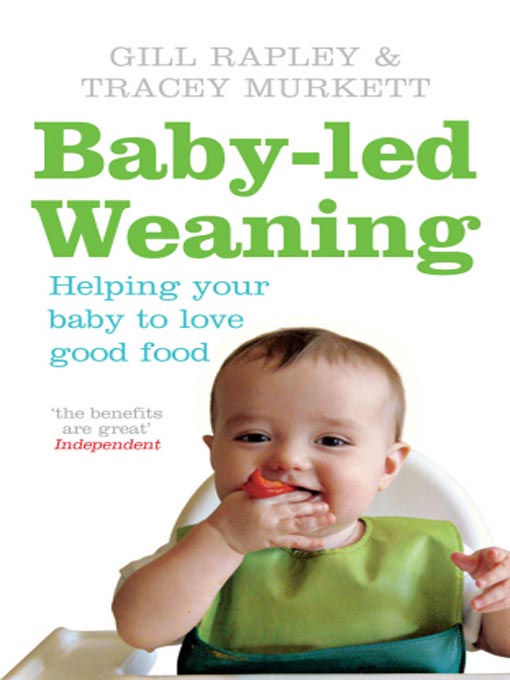 However, “every baby is different,” Dr. Churbock says. Babies who were born early or premature especially might start doing these things at a later age. “You may be watching more for these signs of readiness closer to their corrected age of 6 months (if they had been born on their actual due date), rather than their chronological age of 6 months.”
However, “every baby is different,” Dr. Churbock says. Babies who were born early or premature especially might start doing these things at a later age. “You may be watching more for these signs of readiness closer to their corrected age of 6 months (if they had been born on their actual due date), rather than their chronological age of 6 months.”
Luckily, baby-led weaning meets babies where they are. “This is an approach to feeding that can work and meet children of different ages and abilities where they’re at,” says Dr. Churbock. “At its best, the idea of baby-led weaning should really follow and meet the needs of an individual baby.”
How safe is baby-led weaning?In general, when babies are learning how to feed themselves, they should always be seated upright and well-supported, and they should always be supervised. Parents and caregivers should also limit distractions, Dr. Churbock says. “Avoid eating with the TV on whenever possible.”
And while a baby gagging can be quite frightening, this is actually perfectly normal. “It’s part of a baby actually using muscles properly and protecting their airway,” Dr. Churbock says.
“It’s part of a baby actually using muscles properly and protecting their airway,” Dr. Churbock says.
As with any new skill or milestone, parents may have concerns about safety. For peace of mind, Dr. Churbock recommends parents and caregivers take a child infant CPR course, which will cover important things such as choking management.
Baby-led weaning itself specifically shouldn’t be cause for great alarm. “For babies who are learning a new skill, we want to make sure that it’s as safe as it possibly can be,” says Dr. Churbock. “Studies have shown baby-led weaning, when done properly, isn’t a higher risk for choking.”
However, if babies can’t sit upright with minimal or no support, or if they’re not quite yet reaching for objects and bringing them to the mouth, those are signs they aren’t ready for baby-led weaning.
Advertising Policy
Babies who still have a prominent tongue-thrust reflex, which is commonly seen in infants up until about 6 months of age, also likely aren’t quite there yet.
Great first foods
Cut soft foods into “finger-sized” slices that are made for grasping, says Dr. Churbock. “The food is firm enough that they can pick it up and hold it, long enough that they can have a little portion sticking out of their hand that they can see, and soft enough to gum and chew.” Some examples include:
- Spears of soft ripe fruits, such as banana, pear, avocado, kiwi and mango.
- Strips of roasted, baked or steamed vegetables, such as sweet potatoes, carrots and squash.
- Ground meat or soft, shredded strips of meat that you can move your fingers through
You don’t have to avoid pureed textures completely to do baby-led feeding. “As adults, we eat soft-textured foods, too,” says Dr. Churbock. “Soft foods like oatmeal, applesauce, and plain whole fat or Greek yogurt are great early foods for babies.”
Foods to avoid
Because baby-led weaning exposes babies to foods with different textures, you should avoid serving up foods that are choking hazards. These include:
These include:
- Firm, round foods, such as whole berries and whole grapes.
- Hard, crunchy foods like tortilla or corn chips, popcorn, nuts.
- Raw, hard-textured vegetables like carrots.
- Peanut butter offered alone, which can be too sticky for babies to safely manage.
Dr. Churbock does add that some of the foods above can be served if you prepare them differently. “You’d mush a blueberry to make it a little bit softer or cut it into smaller pieces. For older babies, you’re going to quarter grapes rather than offering them whole.”
Babies under the age of 1 also should never ingest certain foods, including:
- Honey, because of the risk of botulism.
- Whole cow’s milk to drink, because of the risk of digestive tract bleeding and not having the right mix of nutrients. However, small amounts used in cooking or food preparation are generally acceptable, as are other dairy products like yogurt and cheese.
When to introduce allergens
Peanut butter and yogurt can also be allergens.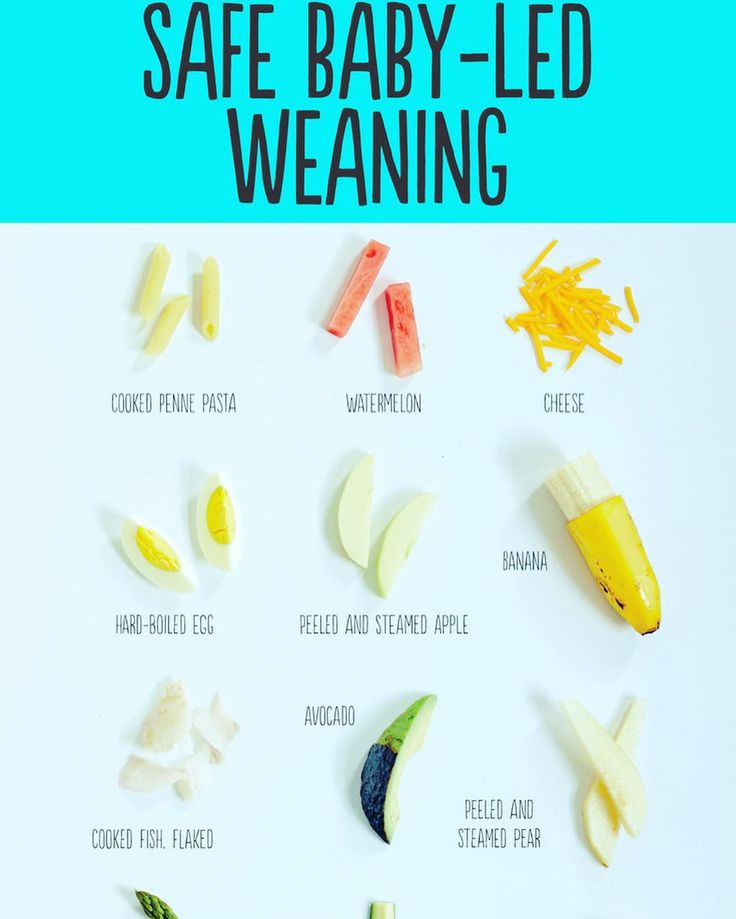 Talk to your child’s pediatrician to learn more about introducing allergenic foods and for further advice on the best early foods to feed your baby. “For most infants, potentially allergenic foods are also important to incorporate early on and often,” says Dr. Churbock. “Some are also great textures for early eaters, like soft strips of egg omelet, or pieces of moist flaky fish like salmon.”
Talk to your child’s pediatrician to learn more about introducing allergenic foods and for further advice on the best early foods to feed your baby. “For most infants, potentially allergenic foods are also important to incorporate early on and often,” says Dr. Churbock. “Some are also great textures for early eaters, like soft strips of egg omelet, or pieces of moist flaky fish like salmon.”
How do I start baby-led weaning?
Before settling on baby-led weaning, Dr. Churbock says parents should first gather as much information as they can — you can often find books on baby-led weaning at your local library — and talk to their baby’s pediatrician.
“Around 4 months of age, start those discussions about how you hope to feed your baby, and what steps you can take for your individual child at that age,” she says. “Talking to your pediatrician is going to be a great first step to go over what to look out for and resources that might be helpful.”
This applies if you’re thinking about baby-led weaning or instead of starting your baby out on purees, Dr. Churbock adds. “Either approach can be appropriate depending on your goals and your individual child’s healthcare needs.”
Churbock adds. “Either approach can be appropriate depending on your goals and your individual child’s healthcare needs.”
Looping a pediatrician or even a speech pathologist into your feeding plans is especially helpful if your baby has unique healthcare considerations such as prematurity; a disorder such as dysphagia, which affects swallowing and feeding; or drinks specialized or thickened formulas. “It’s worth reviewing if there are modifications that can work for most children,” Dr. Churbock says.
Parents and babies can also ease into baby-led weaning together. For example, you might help a baby hold a spoonful of puree, but then allow them to move the spoon to their mouth on their own. “Even if it’s for a short period of time, many babies still do benefit from trying some purees to start,” she says. “You pre-load the spoon, and then your baby can hold the spoon. That’s a nice, easy way to get started.”
However, don’t be afraid to let your baby eat with their hands. “Expect and embrace some mess,” Dr. Churbock says. “Self-feeding is a great sensory experience for babies.”
“Expect and embrace some mess,” Dr. Churbock says. “Self-feeding is a great sensory experience for babies.”
Dr. Churbock says you also shouldn’t worry if your baby doesn’t actually consume much food when first starting solids. “It can take some time for babies to figure out complementary food feeding, and breast milk or formula remains the most important source of nutrition through the first year of life.”
And, above all, if baby-led weaning is slow-going or even isn’t working out, that’s perfectly OK. “There are multiple healthy ways to feed your baby,” Dr. Churbock says. “Feeding methods aren’t always one-size-fits-all, and you don’t have to do things in a certain way.”
Weaning: How To - La Leche League International
HOW DO I WEAN MY BABY?Are you feeling ready to wean completely? Sometimes just cutting back on the amount of times you breastfeed will make you feel better, breastfeeding can sometimes be overwhelming. Breastfeeding is a two-way street. If you resent it when you sit down to breastfeed, your child will pick up on this. If your baby is under a year (or older, sometimes), you will have to substitute a bottle feeding for a missed breastfeeding. An older baby may accept a drink from a cup, a nutritious snack, or just a distraction in the form of a game, a toy, or change of scene. Remember, the first supplemental feed, from a bottle, or of solid food, is the beginning of weaning. Weaning does not need to be all or nothing.
If you resent it when you sit down to breastfeed, your child will pick up on this. If your baby is under a year (or older, sometimes), you will have to substitute a bottle feeding for a missed breastfeeding. An older baby may accept a drink from a cup, a nutritious snack, or just a distraction in the form of a game, a toy, or change of scene. Remember, the first supplemental feed, from a bottle, or of solid food, is the beginning of weaning. Weaning does not need to be all or nothing.
If weaning is your decision, it’s best for you and your baby to do it gradually, and with love. If you wean “cold turkey,” your breasts will likely become painfully engorged, and you might develop a breast infection. Your baby will probably fight the switch from your warm, soft breast to a plastic substitute. He might mourn the loss of “his” breasts.
If you must wean suddenly, see our Weaning: For Medical Reasons article for more information and helpful ideas.
WEANING A BABY UNDER ONE YEARTry first to substitute his least favorite feeding first. If the baby won’t accept the bottle from you, (he knows the breast is right around here somewhere) see if a support person can succeed. It may also be helpful to have you not in the room/home so baby cannot smell you. Let the baby have a few days (or weeks, if possible) between each time you substitute a breastfeeding session with a bottle. Express a little milk from your breasts, to your own comfort, if you become engorged. Don’t express a whole feeding’s worth of milk; just enough to take the pressure off. Your body will get the signal to make less milk over time, slowly. For help with the weaning process contact a La Leche League Leader.
If the baby won’t accept the bottle from you, (he knows the breast is right around here somewhere) see if a support person can succeed. It may also be helpful to have you not in the room/home so baby cannot smell you. Let the baby have a few days (or weeks, if possible) between each time you substitute a breastfeeding session with a bottle. Express a little milk from your breasts, to your own comfort, if you become engorged. Don’t express a whole feeding’s worth of milk; just enough to take the pressure off. Your body will get the signal to make less milk over time, slowly. For help with the weaning process contact a La Leche League Leader.
To quote Dr. William Sears, “There is no set number of years you should nurse your baby.” If you and your child enjoy breastfeeding, there is no reason you need to stop. Both of you will continue to benefit from breastfeeding as long as you like. Many mothers choose to wean naturally, allowing the child to outgrow the need gradually, in his own time.
Breastfeeding an older toddler or child is different from breastfeeding an infant. Most mothers naturally begin to place some restrictions on nursing as their child grows. Sometimes, the mother of an older nursling may become frustrated by other parenting challenges, and think that breastfeeding is causing the difficulty. In fact, raising children is hard work, and the “problem” may be the result of the child’s developmental stage.
In that case, it’s very helpful to learn more about typical childhood behavior and needs. A good place to start is by attending La Leche League meetings. There you will meet mothers who have nursed their children including extended nursing mothers and are happy to share information and ideas with you. Find a group near you.
It is possible to wean during the day but only nurse at night as the nighttime feeding is usually the last to go. Or wean at night but still allow nursing during the day. It does not need to be all or nothing.
TIPS FOR DAYTIME WEANINGGenerally, these strategies work best for daytime nursing.
- Breastfeed the child when he asks, and don’t offer when he doesn’t. This simple technique known as “don’t offer, don’t refuse” may help accelerate the weaning process when used with other methods.
- Change daily routines. Instead of heading home after picking him up from daycare, head to the grocery store or elsewhere instead. Try to avoid the “nursing chair” or other usual “nursing station” in your home as much as possible at the times when he usually would ask to nurse. Stand up as much as possible!
- If possible, get help from other family and household members. If he usually nurses upon waking, try getting up before him and have your partner or someone else do all the morning routine.
- Anticipate nursing sessions and offer substitutions and distractions. Try offering a snack or drink at that time. Take him to his favorite place at the usual nursing time. Other distractions: reading, bike rides, visits from friends, a new toy, walking/singing to the child.

- Shorten the length of nursings or see if he accepts a postponed nursing. Telling him he will be done when you are finishing singing a certain song, or counting to 20 may help with the transition. If he doesn’t understand the concept of waiting or of time, this may not be helpful.
The nap and bedtime nursings are often the last to go and can be more difficult. La Leche League does not advocate for any sleep-training techniques that includes children being left to cry for long periods of time. Staying close to your little one to allow for quick attention before they are fully awake can also help with the overnight times.
- If the child is sleeping with you, you might consider moving him into his own bed or into bed with an older sibling. However, if the child resists the move, he might increase breastfeeding in order to preserve his feeling of closeness with you.
- Allowing another family members to help by taking over sleep-time routines.
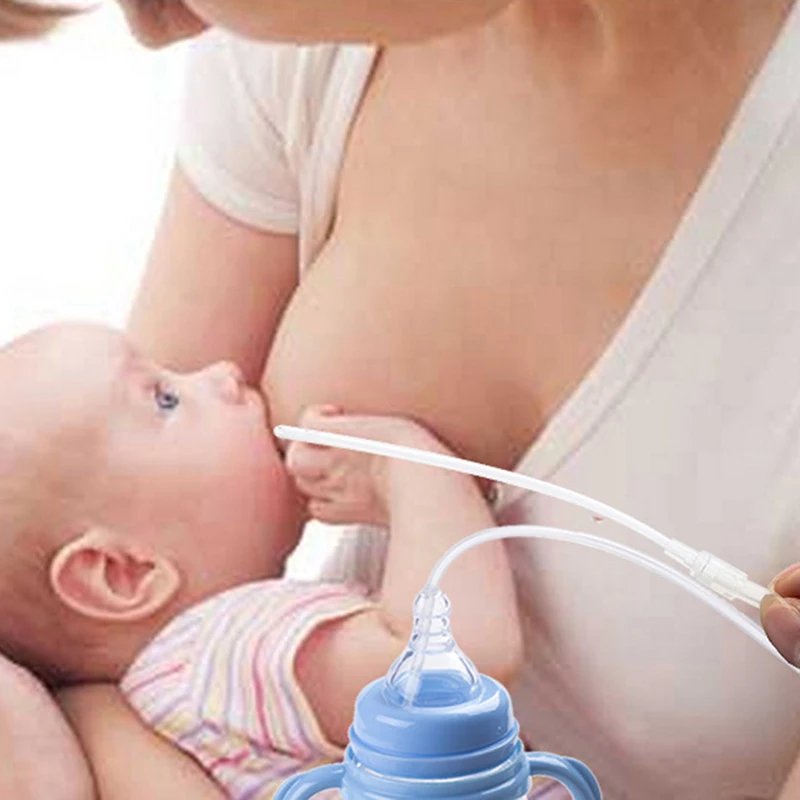
- Offering a drink of water or snack if the child seems hungry or thirsty.
- Offering cuddles, hugs and music to replace nursing at night or for naptime.
If you decide to wean the nighttime feeding, make a bedtime routine not centered around breastfeeding. A good book or two will eventually become more important than a long session at the breast. Your child may agree to rest his head on your breast instead of feeding. Talk to your child about what’s going on ahead of time if you can as he may understand more than you expect.
WHEN A CHILD ISN’T READY TO WEANIf weaning is going too quickly for the child, he’ll usually let you know by his behavior. Increased tantrums, regressive behaviors, anxiety, increase in night waking, new fear of separation, and clinginess are all possible signs that weaning is going too quickly for your child. Illness and teething can also interfere with weaning and it might be necessary to take a break.
Your child may be old enough for you to simply explain to him that you feel it is time to wean. Many children his age or older can understand the concept of stopping nursing. Some mothers let the child pick a date, or choose one themselves, and call that the “weaning day” after which he will no longer nurse. Some mothers will then give the child a “weaning party” with supportive family and understanding friends to help celebrate the milestone. Perhaps the child will receive a special “weaning present.”
Many children his age or older can understand the concept of stopping nursing. Some mothers let the child pick a date, or choose one themselves, and call that the “weaning day” after which he will no longer nurse. Some mothers will then give the child a “weaning party” with supportive family and understanding friends to help celebrate the milestone. Perhaps the child will receive a special “weaning present.”
Some mothers allow the child to choose a coveted toy and buy it after weaning, or buy it before weaning and wrap it up on to be put on a shelf for when the weaning day or weaning party comes.
Obviously, these techniques will not work if the child is extremely resistant to weaning, but many mothers have used them with success. Remember that he will have a continued, perhaps even deepened, need for closeness with you. You can anticipate the child’s need for closeness and spend as much of her day as possible having “special time” with the child.
Weaning can be a difficult time both for mother and child. Mother’s often have many feelings including sadness, anxiety and despair. A La Leche League Leader or group can help you to feel less alone as you go through this big step. To learn more about weaning you can attend a local group or reach out to leader.
Mother’s often have many feelings including sadness, anxiety and despair. A La Leche League Leader or group can help you to feel less alone as you go through this big step. To learn more about weaning you can attend a local group or reach out to leader.
Termination of breastfeeding | Stopping breastfeeding
When is it time to stop breastfeeding and what is the best way to do it? Read our article for useful practical tips on weaning.
Share this information
How long should breastfeeding continue? Three months? Six? Year? Or maybe a few years?
The World Health Organization (WHO) and other authorities recommend that infants be exclusively breastfed for the first six months and then continue to be breastfed along with other foods (complementary foods) for at least two years. 1
The fact is that breast milk is not just food. It is a natural sedative if the child is anxious or tired. In addition, milk contains immune-boosting components, the amount of which increases dramatically when the baby gets sick. 2
In addition, milk contains immune-boosting components, the amount of which increases dramatically when the baby gets sick. 2
According to anthropologists, the natural age of a person to stop breastfeeding is even more than two years. Given factors such as tooth development, body weight, comparison with other primates, and historical evidence, some scientists believe that breastfeeding may last up to two to four years. A number of researchers even believe that our ancestors breastfed children up to six or seven years of age. 3
Today, more than 60% of mothers in developed countries start giving their babies formula or complementary foods before six months of age, 4 although WHO does not recommend this.
When is it time to stop breastfeeding?
Weaning means that you gradually stop breastfeeding your baby. Ideally, the first step in this process is the gradual introduction of complementary foods, starting at about six months of age. In this case, breastfeeding continues. The weaning process continues until the mother's milk has been completely replaced by other foods and drinks.
In this case, breastfeeding continues. The weaning process continues until the mother's milk has been completely replaced by other foods and drinks.
“After six months, the baby needs higher doses of certain nutrients, such as iron, zinc, vitamins B and D, that he cannot get from breast milk or from his own reserves,” says Sarah Beeson, health visitor from Great Britain.
“But solid food should at first only supplement the main diet with breast milk and gradually replace it. Mother's milk remains the main source of nutrition for the baby for many months to come.”
On average, a seven-month-old baby gets 93% of its calories from breast milk. And even between the 11th and 16th months, milk provides him with about half of the daily calorie intake. 5
“Sometimes moms think that breastmilk isn't that important once a baby has started solid foods, but the truth is, no matter how many months old a baby is, there's nothing better than your milk,” continues Sarah.
In fact, the process of finishing breastfeeding can take as long as mother and baby want. “When to stop breastfeeding is up to you,” says Sarah. The only thing that matters is what you think is right for you and your child.”
How to wean
Whenever you decide to start weaning your baby, it's best to do it gradually. An abrupt cessation of breastfeeding can lead to lactostasis, blockage of the milk ducts and mastitis, and in a child such a sudden change can adversely affect the state of the digestive and immune systems. In addition, it will be difficult for both of you psychologically.
When should I stop breastfeeding?
Sometimes mothers mistakenly believe that it is time to stop breastfeeding, when in fact there is no reason to. If you're returning to work, breastfeeding can be a great way to stay close to your baby during this difficult time for both of you. You can express milk at work, and morning and evening feeding sessions will give you the opportunity to spend time alone with your baby. If you need to leave without your baby, you can also express milk and bring or send it home.
If you need to leave without your baby, you can also express milk and bring or send it home.
If you get sick, this is not always a reason to stop breastfeeding. Read our advice in the article on breastfeeding when sick and consult with your healthcare professional.
Weaning up to six months
If you cannot continue breastfeeding until six months and want to try weaning your baby, start by replacing one feeding a day with a bottle of formula.
“It's best to start with midday feedings. Babies are very alert and able to smell breast milk nearby, so ask your partner or relative to give your baby a bottle when you're in the other room,” Sarah advises.
“Be hygienic when preparing meals. Be prepared for the fact that the baby will take fewer servings of expressed milk per day than if he was fed directly from the breast. Don't make him eat more milk than he wants."
You will probably feel that your breasts are fuller and more tender. This is due to the fact that your body is rebuilding to produce less milk. If this creates discomfort, try expressing some milk—just enough to relieve the discomfort without stimulating extra production.
This is due to the fact that your body is rebuilding to produce less milk. If this creates discomfort, try expressing some milk—just enough to relieve the discomfort without stimulating extra production.
When your body adjusts to the new volume - usually after a few days - replace with formula for one more meal a day. Continue this until you have changed all feedings and your baby is completely weaned.
“I had complications after my first birth, as a result I lost a lot of weight very quickly, and besides, I developed mastitis. Lactation was very weak, and at three months I was forced to stop breastfeeding,” recalls Jennifer, a mother of two from the UK, “I gradually replaced one feeding, so physically it was easy, but mentally it was hard for me.”
If you want to maintain closeness with your baby and all the health benefits of breastfeeding, but still need to cut down on breastfeeding, try partial weaning, replacing only a few feeds a day with formula.
Weaning after six months
Once your baby starts eating solid foods (about six months old), you will notice that breastfeeding naturally occurs less and less. For a year, it can be reduced to just a couple of times a day, and feedings will be replaced by full meals and healthy snacks.
For a year, it can be reduced to just a couple of times a day, and feedings will be replaced by full meals and healthy snacks.
Anyway, if you intend to continue to reduce breastfeeding, do it gradually, replacing one feeding at a time. Use formula milk if your baby is under 12 months old. With cow's milk, you should wait at least up to a year.
“When I decided to wean my son, I breastfed him three times a day and gave him other foods three times plus light snacks. Gradually, I replaced all breastfeedings with formula. By 11 months, we only had one nighttime breastfeed left,” says Ruth, a UK mom.
There are various ways to distract a child from changes in his diet. Some mothers suggest that instead of breastfeeding something to drink and eat together to maintain a sense of closeness. You can also change your daily routine, play your favorite game, or replace feeding with caresses - from you or from your partner. Some children take longer to get used to the new food, but in the end everything falls into place.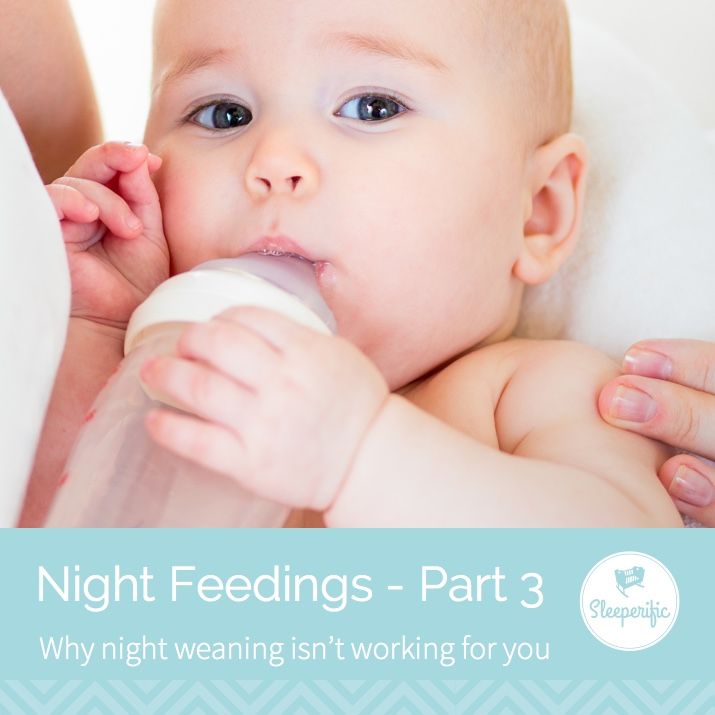 If you are having difficulty weaning, ask your healthcare provider for advice.
If you are having difficulty weaning, ask your healthcare provider for advice.
Ending breastfeeding naturally
Ending breastfeeding can be guided by the baby's wishes. This is called baby-initiated weaning, or the natural termination of breastfeeding. Such a process is likely to be long and gradual. Month after month, feeding sessions will become shorter and less frequent, until one day the child completely loses interest in the breast.
“My daughter stopped breastfeeding on her own when she was four years old,” says Sarah, a mother from the UK. And once, when we were on vacation, she seemed to just forget about her breasts. Now, six months later, she sometimes still asks for breasts, but she already knows that there is no milk there.
You will have a huge amount of time for the body to adapt, so there should be no discomfort or swelling of the breast. However, you may find it difficult emotionally, so spend more time petting and bonding with your baby.
“Child-initiated termination of breastfeeding was right for me because I never gave my son formula or a bottle. I didn’t want to abruptly stop feeding and refuse him,” recalls Kelly, a mother from the UK, “He himself lost interest in breasts at the age of two and a half years. For us, it was the best scenario, although emotionally it was not very easy for me.”
What if you need to stop breastfeeding quickly?
It is best not to stop breastfeeding abruptly, but sometimes it is necessary for medical reasons or because you cannot be near the baby.
If you have been breastfeeding your baby up to this point, you will most likely have to express your milk to avoid breast swelling. Some mothers prefer to use a breast pump for this, others find it easier to express milk manually. You only need to pump a little, just to eliminate the discomfort, otherwise your body will take it as a signal to produce more milk.
At first, the breasts may swell and become tender, but this will pass. Breast milk contains a so-called feedback lactation inhibitor. When breastfeeding is stopped, this inhibitor tells your body to slow down milk production, but it can take days or even weeks for your breasts to rebuild.
Breast milk contains a so-called feedback lactation inhibitor. When breastfeeding is stopped, this inhibitor tells your body to slow down milk production, but it can take days or even weeks for your breasts to rebuild.
Certain medications can relieve pain and should be discussed with your doctor. Always follow your pharmacist's instructions or directions, and consult your healthcare professional before taking any medication.
“I had to abruptly stop breastfeeding when my daughter was eight months old because she had to take strong painkillers,” says Peggy, a mother from Switzerland. “It was very difficult because the baby was constantly looking for a breast and crying. I held her tightly to me as I gave her a bottle. This calmed her, and after a month everything was all right.
Can I continue breastfeeding if I want to get pregnant again?
Breastfeeding is a natural contraceptive. However, this method is not the most reliable, especially after six months or if you are not exclusively breastfeeding. This means that you can get pregnant even while you are breastfeeding.
This means that you can get pregnant even while you are breastfeeding.
Pregnant and breastfeeding mothers sometimes receive conflicting advice about whether to stop breastfeeding. Consistent feeding of two children of different ages is of course possible, and with the advent of the second baby, your body will produce the kind of milk that both of them need.
It is not uncommon for an older child to refuse to breastfeed or skip feedings if the mother is pregnant. This may be due to changes in milk composition that occur during pregnancy. Milk can change the taste and become less sweet. 6 If your baby is under one year of age when he starts to stop breastfeeding, make sure he continues to gain weight.
Talk to your doctor if you want to continue breastfeeding during pregnancy, but have had a preterm birth or miscarriage, or have any bleeding in the past.
If you need medical help to conceive, certain drugs and procedures may not be suitable while you are breastfeeding. Discuss all possible options before deciding to stop breastfeeding.
Discuss all possible options before deciding to stop breastfeeding.
And finally...
Whenever you decide to end breastfeeding, and whatever method you choose to do so, be kind to yourself and your baby. This is a huge change for both of you physically, hormonally, and emotionally, so proceed thoughtfully and carefully.
“Although my body responded normally to stopping breastfeeding, it was psychologically difficult for me. The thing that united us for so long is over, - Jane, a mother of two children from the USA, shares her impressions, - I worked long hours, five days a week, and breastfeeding made me feel that I occupy a special place in the lives of children. But when it stopped, we soon found other ways to be together.”
Literature
1 World Health Organization. [Internet] Health Topics: Breastfeeding: 2018 [Accessed: 02/08/2018]. Available from : http://www.who.int/topics/breastfeeding/en - World Health Organization. "Health Issues: Breastfeeding" [Internet]. Geneva, Switzerland: WHO; 2018 [Visit 02/08/2018]. Article linked: http://www.who.int/topics/breastfeeding/e
"Health Issues: Breastfeeding" [Internet]. Geneva, Switzerland: WHO; 2018 [Visit 02/08/2018]. Article linked: http://www.who.int/topics/breastfeeding/e
2 Hassiotou et al. Maternal and infant infections stimulate a rapid leukocyte response in breastmilk. Clin Transl Immunology. 2013;2(4): e 3. - Hassiot F. et al., "Infectious diseases of the mother and child stimulate a rapid leukocyte reaction in breast milk." Clean Transl Immunology. 2013;2(4):e3.
3 Dettwyler KA. When to wean: biological versus cultural perspectives. Clin Obstet Gynecol . 2004; 47(3)712-723. - Dettwiler KA, "Time to wean: weaning from a biological and cultural point of view". Klin Obstet Ginekol (Clinical obstetrics and gynecology). 2004; 47(3):712-723.
4 Victora CG Breastfeeding in the 21st century: epidemiology, mechanisms, and lifelong effect.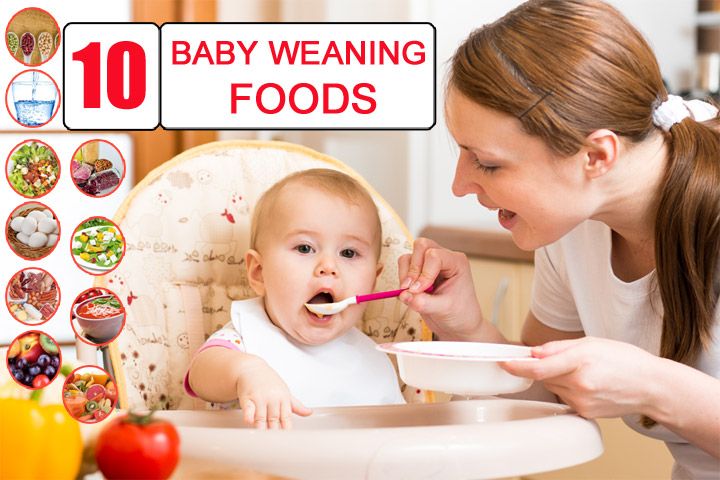 Lancet. 2016;387(10017):475-490. - Victor S.J. et al., "Breastfeeding in the 21st century: epidemiology, mechanisms and long-term effects". Lancet 2016;387(10017):475-490.
Lancet. 2016;387(10017):475-490. - Victor S.J. et al., "Breastfeeding in the 21st century: epidemiology, mechanisms and long-term effects". Lancet 2016;387(10017):475-490.
5 Dewey KG et al. Breast milk volume and composition during late lactation (7-20 months). J Pediatr Gastroenterol Nutr . 1984;3(5):713-720. — Dewey C.G. et al., "Amount and composition of breast milk in late lactation (7-20 months)". F Pediatrician Gastroenterol Nutr. 1984;3(5):713-720.
6 Prosser CG et al. Mammary gland function during gradual weaning and early gestation in women. Aust J Exp Biol Med 9021 9029 Sci. 1984;62( Pt 2):215-228. - Prosser S.G. et al., "Breast Function During Gradual Weaning and Early Gestation." Aust J Exp Biol Med Sai. 1984;62( Pt 2):215-228.
1984;62( Pt 2):215-228.
Doctor "SM-Doctor" told how to properly wean a child from the breast
The baby is crying, the chest is full, but you are determined to curtail breastfeeding. There can be many reasons: it's time to go to work, it's time to send the child to the garden, the state of health, and even "I just decided so."
Weaning can be a real test of strength for the whole family: there are times when children completely refuse to give up their breasts and simply tyrannize their mother, almost tearing off her clothes. Is it possible to avoid problems along the way? How to make the process as comfortable as possible for mom and baby? Parents.ru learned from an expert what mistakes mothers make when weaning a baby.
Tatyana Kuznetsova
pediatrician, nephrologist, breastfeeding consultant at the SM-Doctor clinic in Maryina Roshcha.
Too early
Breastfeeding is a very short period in a child's life. It would be ideal to supplement the child until the age when his need for attachments fades by itself. The age at which the child himself, without mother's help and serious efforts on her part, is ready to give up breastfeeding usually comes after three years. Mom's body is ready to complete lactation earlier - already in 1.5-2 years of the baby.
Completion of lactation at an earlier date is not physiological and, as a rule, is associated with errors and diseases:
- rare feedings,
- by adding water,
- early feeding,
- cracked nipples,
- lactostasis,
- mastitis and, as a result, lack of milk and underweight of the child,
- or maternal health problems.
Weaning before 1-1.5 years is possible, both planned and emergency, and, as a rule, there are good reasons for this: hospitalization of the mother, the need to take medications that are incompatible with feeding the child, situations in the family that require the mother to leave, and others unseen circumstances.
Too fast
First of all, it is very important to determine how ready a particular mother-baby couple is to complete breastfeeding. The readiness of the mother's body is easy to determine. The main indicator is how the breast is filled with milk during a long (up to 12-24 hours) break in the attachment of the baby. If a mother has not fed her child for several hours, and her breasts do not fill up to discomfort and do not need to be pumped, then the mother is ready.
As for the baby, it is considered that the child is ready if he has only 1-3 attachments per day and at the same time he does not suck on nipples (pacifiers, bottles), pens, toys, rags, clothes, bottom sponge and other. In all other cases, it is necessary to gradually reduce the number of applications to 1-3 per day, and only then take the last step.
If the baby is already 1.5 years old, you can try to prepare him for weaning gradually. For this, children older than one and a half years require at least two months. Smooth weaning consists of several stages, each of which can take about 1-2 weeks.
Smooth weaning consists of several stages, each of which can take about 1-2 weeks.
- Cut down on latching while your baby is awake, remove 'bored latching'. Do not provoke the baby: do not change clothes in front of him, do not walk in underwear, do not sit idle in the presence of the child.
- Put your baby to bed without breastfeeding.
- Next, remove the evening falling asleep under the breasts. First, take the breast from the baby if he fell asleep after pumping, but still holds it in his mouth.
Get up early in the morning before your child. Distract to extraneous things, offer to play, look out the window. One fine day, the baby will simply forget to breastfeed in the morning.
In the gradual process of weaning, the most important thing is not to rush things and follow the rule "one step forward, two steps back." Then your weaning will be smooth and painless.
Too radical
Among mothers, extremely traumatic methods of weaning a child from the breast are still practiced - “pulling the breast”, taking drugs that suppress lactation, lubricating the nipples with brilliant green or mustard, leaving home for a day or two / weekends. As a result, this leads to hormonal imbalance, lactostasis and even mastitis in mothers and serious psychological trauma in children. For a child, weaning is a very difficult period in life, and the mother must be there, compensating for the lack of breasts with her attention, affection and care.
As a result, this leads to hormonal imbalance, lactostasis and even mastitis in mothers and serious psychological trauma in children. For a child, weaning is a very difficult period in life, and the mother must be there, compensating for the lack of breasts with her attention, affection and care.
It is also important to take into account that the time of weaning should not coincide with a vacation, a move, a mother's going to work or a baby in a kindergarten, the appearance of a nanny in the house, a child's teething, a baby's illness. In this case, it is better to wean the child 2-3 months before the planned event, or 2-3 months after.
The cessation of breastfeeding should not take place simultaneously with the resettlement of the baby in a separate bed, especially a room. With this it is better to wait 3-4 months. And another factor that you should pay attention to is the psycho-emotional state of the baby. If he is now having a difficult period, he is rebellious or often naughty, it is also better to wait a bit with excommunication.
Too dangerous
Stopping breastfeeding at a stage when the mother’s body is not yet ready for this can lead to serious consequences for her health. In the best case, the mother will be forced to pump regularly for some time. There may also be pain, engorgement of the mammary glands, the development of lactostasis, which is quite difficult for a mother to cope with without the help of a baby. In addition, such an unplanned hormonal restructuring by the body can provoke the development of depressive conditions, as well as prolonged (up to several years!) The release of milk from the mammary glands after the cessation of breastfeeding.
What if…
…doesn't work
By reducing the number of daytime attachments, nighttime attachments may become longer and more frequent for a while. If after a couple of weeks the situation does not change, this most likely means that the child is still difficult to come to terms with such restrictions. In such a situation with weaning, it may be better to wait.
In such a situation with weaning, it may be better to wait.
When a baby begins to suck on his thumb, bottom lip, or anything else, these symptoms cannot be ignored. Your baby is not yet ready to stop breastfeeding. Moreover, this behavior of the baby suggests that it is very difficult for him to come to terms with the ongoing changes, he suffers very much internally. And if you do not treat such a quiet protest of a little man with understanding, this can seriously affect the baby's nervous system in the future.
... the baby himself refused milk until the age of
This cannot be regarded as a physiological event. Many mothers jump at this chance to complete breastfeeding without any problems. However, it may turn out that the baby is not quite ready for weaning yet, and there are important reasons that can provoke this behavior: teething, fever, upper respiratory tract infection, inflammation of the ears, painful jaw movement, nasal congestion, sore throat, wounds, bacterial, fungal infections in the mouth and more.











